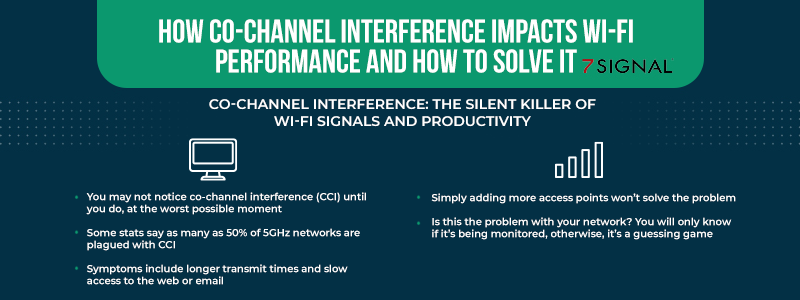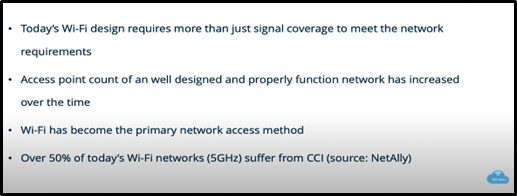Blog
Co-channel interference: the silent killer of Wi-Fi signals and productivity

Co-channel interference (CCI) on a Wi-Fi network is silent and sneaky, appearing intermittently during peak usage. It can stay hidden even in large groups until a participant streams (or attempts to stream) video. What are the symptoms of CCI? How does it affect enterprise Wi-Fi networks in the real world, and what are the impacts? Is there any way to reduce it?
Recently, Tuomas Aaltonen, CWNA and CWSP, a 10-year 7SIGNAL® veteran, conducted a webinar titled Co-Channel Interference: Impact on Performance & How to Minimize It. The limited amount of spectrum offered on the 2.4GHz and 5GHz channels means that access points (APs) may end up using the same channels in some situations, which creates co-channel interference. This is only a problem if many people are in the same room or near the same access points once that video starts, then you get CCI.
The History of CCI
Wi-Fi stations use clear channel assignment (CCA), determining whether a client or AP can transmit. It is meant to avoid collisions if there are two or more clients transmitting at the same time, to ensure the channel is not being used by another device. When APs are using the same channels, CCI occurs. These are basic rules Wi-Fi has to follow:
- If an 802.11 preamble is detected 4dB over noise floor, the station needs to defer from transmitting and wait its turn.
- Wi-Fi spectrum is limited at 2.4 GHz to 3 20MHz (nnon-overlapping) channels and 5GHz to 25 20MHz channels.
- CCI increases when two or more APs are within a certain distance from each other (4dB CCA threshold) are on the same channel.
CCI is a relatively recent phenomenon as Wi-Fi has become the primary network internet access method. Earlier in its evolution, you could have a single access point, and the design didn’t consider CCI at all. Today’s Wi-Fi networks require many more access points, even though we’re limited to the 2.4GHz and 5GHz bands, and there are more and more people using the network.
CCI In Today’a Wi-Fi Environments and Background:

This means CCI issues have increased. The result? A great user experience is only available when utilization is zero to 20%, but it degrades from there.
The symptoms of CCI
CCI occurs when channel utilization is over 50%. From 50% to 80% utilization, the user experience will degrade for VOIP and video terminals as well as some other devices. Once utilization is over 80%, every user on every device will have a degraded experience.
Higher airtime utilization means longer transmit wait times for clients and APs. What does that mean in real terms? When your Wi-Fi network is suffering from CCI, you’ll notice network slowdowns as well as:
- Longer transmit times
- A wait to connect to the network
- Roaming isn’t reliable
- Sometimes a complete loss of connection
Everything will be slowed down. Emails take a long time to download, and web pages load slowly.
What affects CCI
Utilization is a factor, such as at night when there is a lot of traffic, but its not the only factor affecting CCI. Physical factors, as well as overall network design, play a part, including:
- The number of SSIDs (network names) used
- Where APs are located and what types of antennas are used
- The power level of the APs
- Channel widths used
- Data rates
Physical barriers also affect Wi-Fi performance and create CCI. Wall attenuation, the absorption of Wi-Fi signals by building materials such as drywall, used in most interior walls, can weaken signals cause reduced signal strength. The attenuation of the floor also must be considered. However, these physical barriers can also be used when designing a network to decrease CCI because they, in a minor way, isolate signals to reduce CCI.
Adding more APs won’t solve the problem
There’s a common misconception that adding more APs can solve the CCI problem.
For example, most offices today are open concept. Large spaces require multiple access points for good coverage. You would assume that this would give you what you need, but you know that the number of APs is only one factor. In this case, if there are multiple access points in the same room on the same channel, you will encounter CCI, negatively impacting your Wi-Fi performance.
The role of antennas in CCI
The antenna type also plays a part in CCI. Antennas can be directional, omnidirectional, internal, and external. Directional antennas focus the RF energy where it’s most needed and wanted to reduce CCI. On the other hand, an omnidirectional antenna will blast that RF energy in equal strength 360 degrees, and that increases CCI. In a challenging environment, external antennas are often required.
When it comes to CCI, it takes more than monitoring RF space and APs. You have to consider your neighbors who may be consuming all the channels within a certain range. That channel then becomes congested and unusable, so your own Wi-Fi design planning must be based on different channels.
Minimizing the impact of CCI
Minimizing the impact of CCI starts with the design of your network, including taking advantage of existing features, such as wall attenuation. Directional antennas also offer better control of the air space and focus RF energy where you want it. In addition:
- In your design, take advantage of wall attenuation. Sometimes maximizing the cell size of a single AP isn’t ideal. Instead, attempt to focus the RF energy of that AP to an area where clients need it.
- Use directional antennas in challenging environments such as high-density atriums, arenas, and halls to help control the air space and focus the RF energy where it’s needed.
- Limit the transmit power of access points.
- Use all the 5GHz channels to maximize the spectrum.
- Use 20 MHz channel widths in dense areas where CCI becomes an issue when using 40 or 80 MHz channel widths.
- Remove channels that are congested by your neighbors.
- Pay attention to management frame overhead – limit the number of access points per channel.
What’s causing your Wi-Fi issues? Is network performance being monitored? CCI is a common problem and could create network slowdowns, but is only one potential cause. Solving these issues can be complex, and not addressing them can cause frustration and crater productivity.
How 7SIGNAL can help
The 7SIGNAL platform is an invaluable tool for addressing the challenges posed by co-channel interference in Wi-Fi networks. By leveraging the capabilities of the 7SIGNAL platform, you gain insights into the impact of co-channel interference on performance.
Through comprehensive monitoring, management, and measurement of airtime utilization, you’ll be able to make informed decisions to optimize network performance and mitigate the negative effects of interference. With powerful visualization features and optimization techniques provided by 7SIGNAL, Wi-Fi environments can be effectively optimized, ensuring a seamless and efficient user experience.
The 7SIGNAL platform is designed for the world's most innovative organizations, educational institutions, hospitals, and government agencies and is currently deployed at IBM, Kaiser Permanente, Nike, and other Fortune 500 companies. 7SIGNAL continuously monitors the connectivity of an estimated 20 million global devices. Learn more at www.7signal.com and request your free trial.